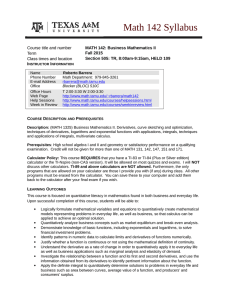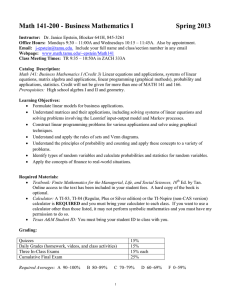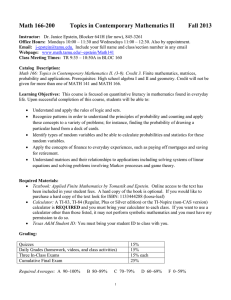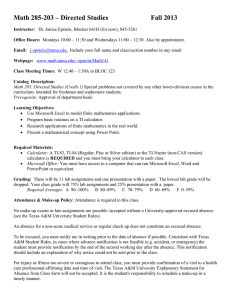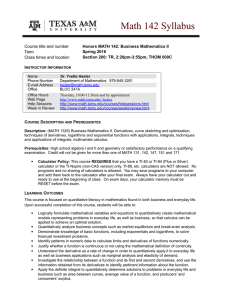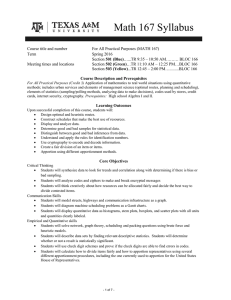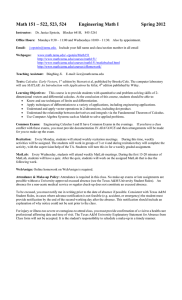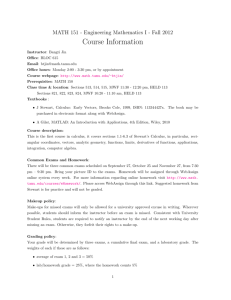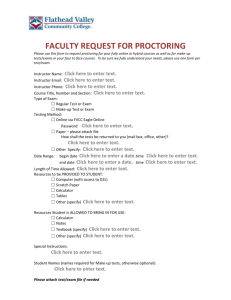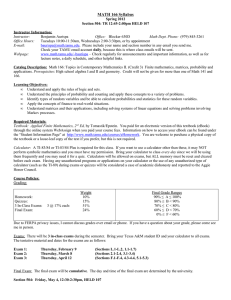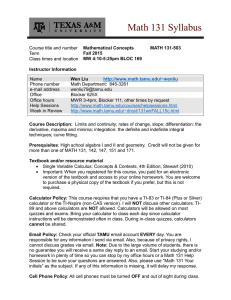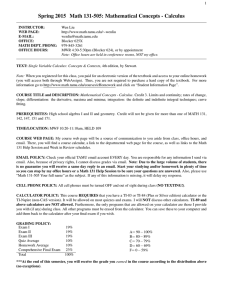Math 142 Syllabus
advertisement
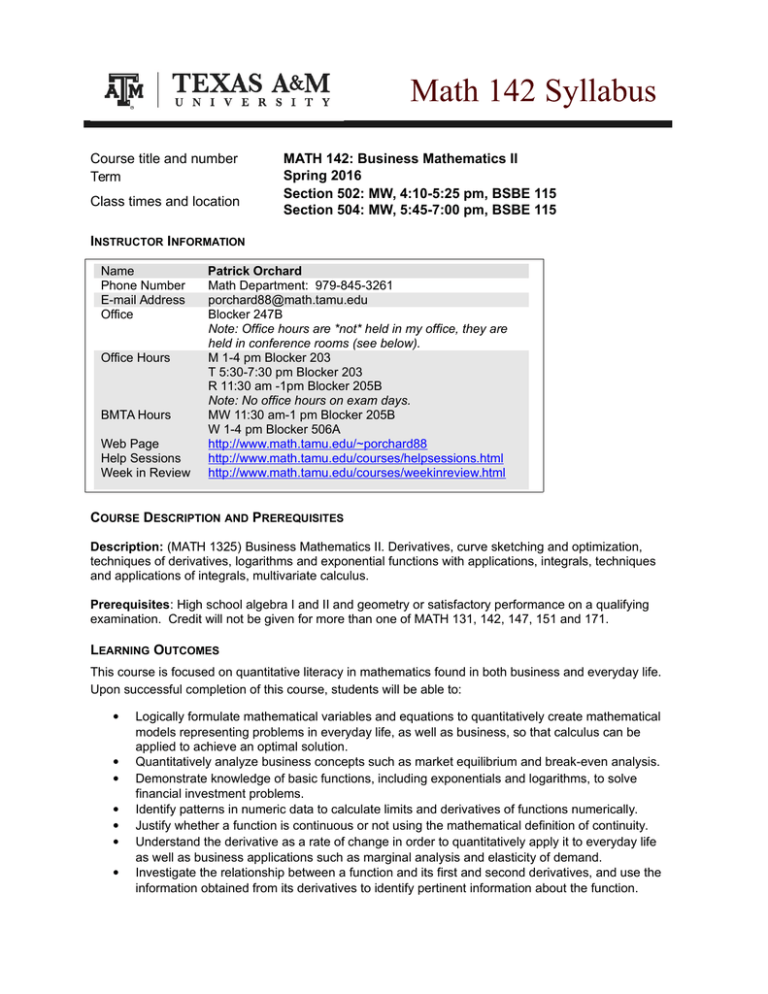
Math 142 Syllabus Course title and number Term Class times and location MATH 142: Business Mathematics II Spring 2016 Section 502: MW, 4:10-5:25 pm, BSBE 115 Section 504: MW, 5:45-7:00 pm, BSBE 115 INSTRUCTOR INFORMATION Name Phone Number E-mail Address Office Office Hours BMTA Hours Web Page Help Sessions Week in Review Patrick Orchard Math Department: 979-845-3261 porchard88@math.tamu.edu Blocker 247B Note: Office hours are *not* held in my office, they are held in conference rooms (see below). M 1-4 pm Blocker 203 T 5:30-7:30 pm Blocker 203 R 11:30 am -1pm Blocker 205B Note: No office hours on exam days. MW 11:30 am-1 pm Blocker 205B W 1-4 pm Blocker 506A http://www.math.tamu.edu/~porchard88 http://www.math.tamu.edu/courses/helpsessions.html http://www.math.tamu.edu/courses/weekinreview.html COURSE DESCRIPTION AND PREREQUISITES Description: (MATH 1325) Business Mathematics II. Derivatives, curve sketching and optimization, techniques of derivatives, logarithms and exponential functions with applications, integrals, techniques and applications of integrals, multivariate calculus. Prerequisites: High school algebra I and II and geometry or satisfactory performance on a qualifying examination. Credit will not be given for more than one of MATH 131, 142, 147, 151 and 171. LEARNING OUTCOMES This course is focused on quantitative literacy in mathematics found in both business and everyday life. Upon successful completion of this course, students will be able to: Logically formulate mathematical variables and equations to quantitatively create mathematical models representing problems in everyday life, as well as business, so that calculus can be applied to achieve an optimal solution. Quantitatively analyze business concepts such as market equilibrium and break-even analysis. Demonstrate knowledge of basic functions, including exponentials and logarithms, to solve financial investment problems. Identify patterns in numeric data to calculate limits and derivatives of functions numerically. Justify whether a function is continuous or not using the mathematical definition of continuity. Understand the derivative as a rate of change in order to quantitatively apply it to everyday life as well as business applications such as marginal analysis and elasticity of demand. Investigate the relationship between a function and its first and second derivatives, and use the information obtained from its derivatives to identify pertinent information about the function. Apply the definite integral to quantitatively determine solutions to problems in everyday life and business such as area between curves, average value of a function, and producers’ and consumers’ surplus. Recognize and appreciate the relationship between the derivative (rate of change) and the definite integral (accumulation of change), and utilize the Fundamental Theorem of Calculus as the bridge between the two. Generalize and extend the pattern of various calculus techniques to functions of two variables in order to find solutions to both everyday and business problems such as marginal productivity of labor and capital. TEXTBOOK AND/OR RESOURCE MATERIAL Textbook: Calculus: Applications and Technology, 3rd edition, by Tomastik Note: When you registered for this class, you paid for an electronic version of the textbook and access to your online homework (you will access both through WebAssign). Thus, you are not required to purchase a hard copy of the textbook. For more information go to http://www.math.tamu.edu/courses/eHomework/ and click on “Student Information Page”. Calculator Policy: This course REQUIRES that you have a TI-83 or TI-84 (Plus or Silver edition) calculator or the TI-Nspire (non-CAS version, with the TI-84 faceplate). I will NOT discuss other calculators. TI-89 and above calculators are NOT allowed. Furthermore, the only programs that are allowed on your calculator are those I provide you with (if any) during class. All other programs must be erased from the calculator. You can save these to your computer and add them back to the calculator after your final exam if you wish. Course Web Page: My course web page will be a source of communication to you aside from class, office hours, and email. There, you will find a course calendar, a link to the departmental web page for the course, as well as links to the Math 142 Help Session and Week in Review schedules. Email: Check your official TAMU email account EVERY day. You are responsible for any information I send via email. Also, because of privacy rights, I cannot discuss grades via email. Also, please include your full name, course number (142), and section number in your email. If any of this information is missing, it will delay my response. Note: Due to the large volume of students, it may take me a few days to respond to an email. If you have a question about a homework problem, you need to stop by my office hours, your BMTA’s office hours, or a Math 142 Help Session. Be sure to start your studying and homework early so you can make arrangements to attend one of the above resources for help. GRADING POLICIES The course grading will be based on the results of Exams: There will be three in-class exams and a comprehensive final exam. You must bring a picture ID (student ID or driver's license) to the exams. The exams are all multiple choice, and there will be no partial credit. You will have 70 minutes to complete the exam. You will need a gray TAMU scantron for each exam. More information regarding exams will be given closer to the first exam day. The final exam is a 2 hour exam. It is also all multiple choice, and no partial credit will be given. You will need a gray TAMU scantron for the final exam as well. After your test has been returned to you, if you believe there is an error in the grading, you must come to me within a week of getting your test back in order for me to change the grade. Graded Homework: Some graded homework assignments will be completed online using your WebAssign computer account, while others may be given as take-home assignments. Additional information regarding online homework: o o o o o o Go to http://www.math.tamu.edu/courses/eHomework/ to access your online homework (as well as tutorials for how to use WebAssign). You have a “practice” version and a “homework” version for each assignment. There are 20 attempts for each question in the practice version, and you have 3 attempts for each question in the homework version (you can submit the answer(s) to each question individually). The practice versions are NOT counted toward your grade. After submitting an answer in the practice version, you will see the correct answer. It is very important that you work the practice version at least once so you will see the format you need to use for your answers in WebAssign. You should use Mozilla Firefox and have the most updated versions of Java and Flash on the computer you are using to alleviate technical problems. If you have technical issues with WebAssign, please fill out the “Student Help Request Form” found at http://www.math.tamu.edu/courses/eHomework/. I will not give an extension due to technical difficulties, so be sure to start your homework well in advance so that you have time to resolve any technical issues. Exams Timeline Activity Exam I Exam II Exam III Homework Final Exam Date Feb. 10 Mar. 23 Apr. 20 Weekly (Thursdays) 502: May 6, 3:30-5:30 pm 504: May 5, 7:30-9:30 am TOTAL Percent 20% 20% 20% 15% 25% 100% Grading Scale Range 90-100% 80-89% 70-79% 60-69% 0-59% Grade A B C D F Note: At the end of this semester, you will receive the grade you earned in the course according to the distribution above (no exceptions). ATTENDANCE AND MAKE-UP POLICIES Excused Absences: No make-ups will be given without written evidence of an official University excused absence (see University Student Rules). In addition, you must notify me NO LATER than the end of the second working day after the missed assignment: ... the student must notify his or her instructor in writing (acknowledged e-mail message is acceptable) prior to the date of absence if such notification is feasible. In cases where advance notification is not feasible (e.g. accident or emergency) the student must provide notification by the end of the second working day after the absence. This notification should include an explanation of why notice could not be sent prior to the class. (Section 7.3 of the University Student Rules) ***If no such notice is given, the rights to a make-up are forfeited. Specifically, in the case of injury or illness, students are required to obtain a confirmation note from a health care professional affirming date and time of a medical office visit regarding the injury or illness. I will NOT accept the “Explanatory Statement for Absence from Class” form as sufficient written documentation of an excused absence. For more information regarding excused absences, refer to Student Rule 7 of the University Student Rules at http://student-rules.tamu.edu/rule07. Make-up Exams: If you have a written, University approved excused absence for missing an exam *and* you contact me within 2 working days after missing an exam, you will be expected to make-up your exam through the Math Department at the next possible make-up exam time (see http://www.math.tamu.edu/courses/makeupexams.html to find the next possible make-up exam time and location). If you do not complete your make-up exam on the next available make-up day, you must have a University approved excused absence (in writing) for ALL the possible make-up days you do not attend, in addition to the regular exam day you missed (see Student Rule 7 of the University Student Rules). Remember to contact me within 2 working days if you miss an exam, so that I can schedule your make-up exam with the Math Department for the next possible make-up exam time. Note: The make-up exams will cover the same material, but they are not multiple choice. They will be workout as well as short answer for the conceptual questions. You should study the same way you would for the original exam. Late Work: Late work (for which you do not have a University approved excused absence) will NOT be accepted. ADDITIONAL PRACTICE & SOURCES OF HELP BMTA Office Hours: My BMTA’s for both sections (Claire and Madison) will conduct their own office hours each week. These office hours will be an excellent source of help to you especially if you cannot attend my office hours. They are extremely knowledgeable of the material and are wonderful teachers. They will be able to help you with online homework (the practice versions), class notes, week in review solutions (take them with you), etc. Suggested Homework: A list of suggested homework problems will be posted on the course web page. These problems will not be collected for a grade, but it is IMPERATIVE that you do the assigned problems on the suggested homework problems list to prepare for the exams. The best way to learn anything (including math!) is to practice it. If you need help with any of these suggested homework problems, please attend my office hours, your BMTA's office hours, or a Math 142 Help Session. Week in Review: Math 142 has two Week in Review sessions: one held by me (Tuesdays 7:30-9:30 in Blocker 169) and the other by Ms. Allen (Mondays 7:15-9:15 in Blocker 169). They will cover the material taught in class the previous week. The direct link to the Week in Review can be found on our course web page. There, you will find the times, locations, and practice problems for each review. You should print the practice problems and bring them with you to the Week in Review. Note: There is no Week in Review the week after an exam. Help Sessions: The times and locations for Math 142 Help Sessions will be announced by the second week of classes and can be found on the course web page. The help sessions have drop-in hours where you can get help with your suggested homework, online homework, class notes, or other problems. These help sessions are an excellent source of help, especially if you are unable to attend my office hours or your BMTA’s office hours. Your Classmates: You are encouraged to work together and study together, but you must turn in your own assignments. Copying answers is an act of scholastic dishonesty and will NOT be tolerated. ELECTRONIC DEVICES POLICY Cell phones must be turned off and out of sight during class. If I hear or see your cell phone, I may ask you to leave class (this is in accordance with University Student Rules). Calculators are allowed to be on during class while being used for math. You should always have your calculator out and ready to use by the time class starts. On exam days, you are not allowed to have your calculator lid out, and your calculator memory must be RESET before entering the room. You are NOT allowed to have any other electronic device (computer, ipod, ipad, etc.) out or turned on during class. COURSE TOPICS (Tentative weekly schedule) WEEK TOPIC REQUIRED READING A.8: Brief review of basic functions and shifts, 1.0: Complete Graphs, 1.1 topics: Increasing, Decreasing, Concavity, Continuity, and Piecewise-defined Functions, 1.2 topics: Break-even Analysis and Market Equilibrium, Exponential Functions Logarithmic Functions, Limits and Continuity Rates of Change, The Derivative Review, Exam I (A.8, 1.0, 1.1 topics, 1.2 topics, 1.3, 1.5, and 3.1-3.3) Simple Derivative Rules and Marginal Analysis, Product and Quotient Rules, Chain Rule Derivatives of Exponential and Logarithmic Functions, Elasticity of Demand, Analyzing Graphs with the First Derivative Analyzing Graphs with the Second Derivative, Limits at Infinity, Curve Sketching Techniques Absolute Extrema, Optimization (Inventory Control is optional) Spring Break Review, Exam II (4.1-4.5 and 5.1-5.6) Antiderivatives, Substitution, Riemann Sums and Estimating Distance The Definite Integral, Fundamental Theorem of Calculus and Average Value of a Function, Area Between Curves (Lorentz Curves are optional) 6.7 topic: Producers’ and Consumers’ Surplus, Functions of Several Variables, Partial Derivatives (Competitive and Complementary Demand is optional)Review Review, Exam III (6.1-6.6, 6.7 topic, 8.1, and 8.2) Extrema, Review for Final Exam Review for the Final Exam, Final Exams (covering all previous sections as well as Section 8.3) Sections A.8, 1.0, 1.1 topics, 1.2 topics, 1.3 OF 1/18 1/25 2/1 2/8 2/15 2/22 2/29 3/7 3/14 3/21 3/28 4/4 4/11 4/18 4/25 5/2 Sections 1.5, 3.1 Sections 3.2, 3.3 Sections 4.1, 4.2, 4.3 Sections 4.4, 4.5, 5.1 Sections 5.2, 5.3, 5.4 Sections 5.5, 5.6 Sections 6.1, 6.2, 6.3 Sections 6.4, 6.5, 6.6 Sections 6.7 topic, 8.1, 8.2 Section 8.3 AMERICANS WITH DISABILITIES ACT (ADA) The Americans with Disabilities Act (ADA) is a federal anti-discrimination statute that provides comprehensive civil rights protection for persons with disabilities. Among other things, this legislation requires that all students with disabilities be guaranteed a learning environment that provides for reasonable accommodation of their disabilities. If you believe you have a disability requiring an accommodation, please contact Disability Services, currently located in the Disability Services building at the Student Services at White Creek complex on west campus or call 979-845-1637. For additional information, visit http://disability.tamu.edu ACADEMIC INTEGRITY Copying work done by others, either in-class or out-of-class, is an act of scholastic dishonesty and will be prosecuted to the full extent allowed by University policy. Collaboration on assignments, either in-class or out-of-class, is forbidden unless I grant permission. If you cheat on an assignment, you will receive a zero. Also, you will be reported to the University. Another form of cheating is typing formulas in the calculator or using programs that give you an advantage over classmates. If I catch anyone cheating this way, you will get a zero on the assignment and be reported to the University for cheating. Remember the Aggie Code of Honor: “An Aggie does not lie, cheat, or steal, or tolerate those who do.” For more information about the Honor Council Rules and Procedures visit the web page http://aggiehonor.tamu.edu. Scholastic Dishonesty Will Not Be Tolerated. COPYRIGHT POLICY All printed materials disseminated in class or on the web are protected by Copyright laws. One copy or download from the web) is allowed for personal use. Multiple copies or sale of any of these materials is strictly prohibited.
